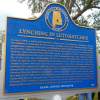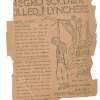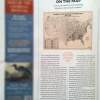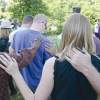"EJI believes that truthfully acknowledging this history is vital to healing and reconciliation. As part of its effort to help towns, cities, and states confront and recover from tragic histories of racial violence and terrorism, EJI is joining with communities to install historical markers at the sites of lynchings..."
A lynching kept out of sight (Felix Hall, Georgia)
...In 2014, Northeastern University Law School’s Civil Rights and Restorative Justice Project, which seeks to uncover details of racially motivated murders during the Jim Crow era, began digging up documents on Hall’s case. Those documents were turned over to Northeastern’s School of Journalism, prompting a year-long investigation into the lynching and the government’s failure to see justice done.
Putting Lynching on the Map
On a Sunday afternoon in May, more than 100 people gathered on a grassy knoll sandwiched between a swamp and a construction company lot on the eastern outskirts of Memphis, Tennessee. Two high school juniors, Khamilla Johnson and Khari Bowman, stood before them and described how, exactly 99 years ago, a crowd at least 50 times as large had come to this very spot to watch the lynching of a black man named Ell Persons.
1917 Lynching Recalled, Marker Planned at Site
In a year, a group of religious leaders hopes to draw at least 5,000 Memphians to an area off Summer Avenue by the Wolf River where 3,000 gathered nearly a century ago as a man was burned alive.
The Lynching Sites Project of Memphis gathered Sunday, May 22, in a field by a Wolf River oxbow, 99 years to the day that Ell Persons was lynched at an event that was covered by local newspapers in advance.
Burned Alive: The Lynch Murder, Mutilation and Mayhem of Ell Persons
On Tuesday, April 12 [2016] the American Inns of Court in Memphis, Tennessee invited me and other members of the Lynching Sites Project to come and share the story of the lynching of Ell Persons. Attorney Carla Peacher-Ryan and Dr. Tom Carlson promoted the work we do in the recovering of lynching sites in Shelby County, while Dr. Margaret Vandiver discussed the broader implications of the Persons lynching. I had the task of giving a speech detailing Persons lynching and the aftermath.
Memphis Burning
Last winter, with a scrawled list of the streets and landmarks mentioned in 100-year-old newspaper articles, I drove east through Memphis, past Shelby Farms, to what I believed might have been the place where a black woodchopper named Ell Persons was burned alive before thousands of spectators. I walked along the edge of the Wolf River, unsure whether this was the place. The river was narrower than I expected, and the bridge was newer than I thought it should have been.
In Memphis, A Movement To Mark Lynching Sites
As racial tensions continue to make headlines around the country, one group in Memphis has banded together to take action. Sharon Pavelda, a founding member of Responding to Racism, joins Here & Now’s Jeremy Hobson to explain the group’s push to mark the sites of lynchings that happened in the past – as a way to move forward.
Healing our history, healing ourselves
On May 22, 1917, at the Old Wolf River bridge, a black man was doused with gasoline and thrown alive into a bonfire. Five thousand people watched. The crowd was unusually large because of an announcement of the place and time in the Memphis press and the fact that a number of county schools had been let out early so students could attend.
Memphis group joins effort to identify, memorialize all lynching sites in the South
A local church-based group is working to locate and memorialize the site of every post-Civil War lynching in Shelby County.
The group, which is calling itself "Responding to Racism," is led by three retirees, all white and all members of First Congregational Church.
Rev. Randall Mullins, a retired United Church of Christ minister, sent an email to more than a dozen local clergy on Friday asking them to join the effort and recruit others.
Memphis and the Lynching at the Curve
Thomas Moss symbolized the urban entrepreneurial class of African Americans that emerged in the decades following the Civil War. Moss invested in a community-owned grocery store, the People’s Grocery, which he managed at night after spending his days working as a postman. The People’s Grocery was located at the southeast corner of what is today Mississippi Blvd and Walker Ave, known then as “the Curve” for the distinctive turn that streetcars made at the corner.
History of Lynchings in the South Documents Nearly 4,000 Names
On Tuesday, the organization he founded and runs, the Equal Justice Initiative in Montgomery, Ala., released a report on the history of lynchings in the United States, the result of five years of research and 160 visits to sites around the South. The authors of the report compiled an inventory of 3,959 victims of “racial terror lynchings” in 12 Southern states from 1877 to 1950.
Lynching in America: Confronting the Legacy of Racial Terror
Lynching in America: Confronting the Legacy of Racial Terror documents EJI’s multi-year investigation into lynching in twelve Southern states during the period between Reconstruction and World War II. EJI researchers documented 4075 racial terror lynchings of African Americans in Alabama, Arkansas, Florida, Georgia, Kentucky, Louisiana, Mississippi, North Carolina, South Carolina, Tennessee, Texas, and Virginia between 1877 and 1950 – at least 800 more lynchings of black people in these states than previously reported in the most comprehensive work done on lynching to date.













